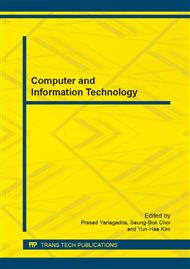[1]
I. Goldberg, Ed., A pseudonymous communications infrastructure for the internet. UC Berkeley Working Paper, 2000, p. ^pp. Pages.
Google Scholar
[2]
D. Liu and X. Chen, Rumor Propagation in Online Social Networks Like Twitter—A Simulation Study, presented at the 2011 Third International Conference on Multimedia Information Networking and Security, (2011).
DOI: 10.1109/mines.2011.109
Google Scholar
[3]
H. Tran, et al., Spam detection in online classified advertisements, presented at the Proceedings of the 2011 Joint WICOW/AIRWeb Workshop on Web Quality, Hyderabad, India, (2011).
DOI: 10.1145/1964114.1964122
Google Scholar
[4]
A. G. West and I. Lee, Towards the effective temporal association mining of spam blacklists, presented at the Proceedings of the 8th Annual Collaboration, Electronic messaging, Anti-Abuse and Spam Conference, Perth, Australia, (2011).
DOI: 10.1145/2030376.2030385
Google Scholar
[5]
N. Jindal and B. Liu, Opinion spam and analysis, presented at the Proceedings of the international conference on Web search and web data mining, Palo Alto, California, USA, (2008).
DOI: 10.1145/1341531.1341560
Google Scholar
[6]
Y. Oh, et al., Empirical analysis of Internet identity misuse: case study of South Korean real name system, in Proceedings of the 6th ACM workshop on Digital identity management, 2010, pp.27-34.
DOI: 10.1145/1866855.1866863
Google Scholar
[7]
Twitter. Available: Http: /www. twitter. com.
Google Scholar
[8]
Weibo. Available: Http: /www. weibo. com.
Google Scholar
[9]
Y. Wang and J. Li, An economic analysis of the price system of real-name system for train ticket, in 3rd International Conference on Transportation Engineering, ICTE 2011, July 23, 2011 - July 25, 2011, Chengdu, China, 2011, pp.452-457.
DOI: 10.1061/41184(419)75
Google Scholar
[10]
B. Dun, et al., Study on the real-name system technology for the ontology of internet medicine market, in International Conference on Computer, Informatics, Cybernetics and Applications 2011, CICA 2011, September 13, 2011 - September 16, 2011, Hangzhou, China, 2012, pp.1471-1477.
DOI: 10.1007/978-94-007-1839-5_158
Google Scholar
[11]
A. Pfitzmann and M. Koehntopp, Eds., Anonymity, unobservability, and pseudonymity—a proposal for terminology. Springer, 2001, p. ^pp. Pages.
Google Scholar
[12]
D. Boyd, Privacy and Security, The Politics of Real Names, Communications of the ACM, vol. 55, pp.29-31, 2012. 8.
Google Scholar


